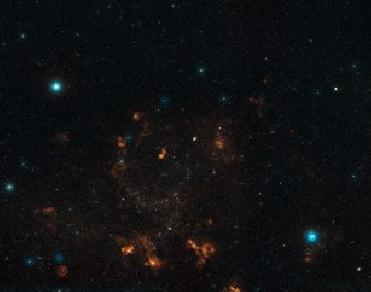
This wide-field view shows a section of the Large Magellanic Cloud, centred on the unusual globular cluster NGC 1978. An ESO Photo
PARIS (BNS): A new image of the Large Magellanic Cloud (LMC) � a galaxy nearby our Milky Way � has unraveled a �cosmic zoo� inside it containing vast globular clusters and remnants of stellar explosions.
The LMC lies in the constellation of Dorado (the Swordfish), deep in the southern sky. With a mass less than one-tenth of the mass of Milky Way, it is categorised as an irregular dwarf galaxy.
In the new image, obtained from the European Southern Observatory�s Wide Field Imager, the LMC is seen as a rich bed of dozens of young star clusters and glowing gas clouds.
While many of the globular clusters orbiting the Milky Way are quite old, containing primarily old red stars, one of the clusters in the LMC is estimated to be quite young. The NGC 1978, an unusually massive globular cluster, is just 3.5 billion years old.
The presence of this kind of object in the LMC leads astronomers to think that the galaxy has a more recent history of active star formation than our own Milky Way, ESO said.
Besides being a vigorous star forming region, the Large Magellanic Cloud has also witnessed the demise of several stars in the form of supernova explosions. A remnant of one such exploded supernova � DEM L 190 which is a �strangely shaped wispy cloud� � has been spotted in the new image.
This giant cloud of glowing gas is the brightest supernova remnant in the LMC and is about 30 light-years across. At the centre, where the star once burned, now lies a magnetar � a neutron star with an extremely powerful magnetic field.
With such varied features and phenomena, the new-found region of the LMC offers researchers a vast area to explore in greater detail.
 Previous Article
Previous Article Next Article
Next Article













The Indian Air Force, in its flight trials evaluation report submitted before the Defence Ministry l..
view articleAn insight into the Medium Multi-Role Combat Aircraft competition...
view articleSky enthusiasts can now spot the International Space Station (ISS) commanded by Indian-American astr..
view article